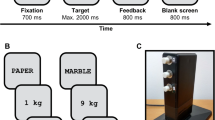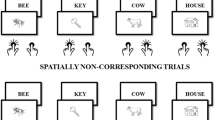Abstract
Stimuli associated with large quantities are typically responded to faster with a right- than a left-side key, whereas stimuli associated with small quantities are typically responded to faster with a left- than a right-side key. This phenomenon is known as the spatial-quantity association of response codes (SQUARC) effect. Here, in two experiments, we explored whether a SQUARC effect can emerge for light versus heavy items. Participants judged whether the weight associated with a central target word, describing an animal (e.g. ‘cow’; Experiment 1) or a material (e.g. ‘iron’; Experiment 2), was lighter or heavier than the weight associated with a reference word. Responses were provided with a left- and a right-side button. Then, participants estimated the weight associated with target and reference words. In both experiments, evidence for a SQUARC effect emerged. Moreover, response times for each target word decreased with absolute difference between its rated weight and the rated weight of the reference word, in line with a distance effect. Overall, these results provide evidence of a possible spatial representation of weight.






Similar content being viewed by others
Notes
Even if in English the word ‘light’ may refer not just to lightness in weight, but also to lightness in colour, in Italian there is no obvious confounding for words related to weight and words related to other physical dimensions. For instance, there is no confounding between the Italian words ‘leggero’ (light in weight) and ‘chiaro’ (light in colour).
The SNARC effect is frequently tested by computing, for each number stimulus, the mean RT difference between the right- and the left-side key, and then by testing the existence of a negative correlation between number magnitudes and mean RT difference (see Fias et al. 1996). Theoretically, this approach could also be used in the current context by using the mean rated weight of the stimuli instead of number magnitude. However, when magnitude is task relevant as in our study (see the general discussion), the mean RT difference is not a linear but a categorical function of magnitude, which implies the violation of one basic assumptions of linear regression analysis (see Gevers et al. 2006).
Please note that anchors and target words belonged to different categories (i.e. objects vs. materials, respectively). For the sake of reliability of the rating scale, the weight implied by the two anchors should be represented similarly among participants, and we reasoned that this was more easily achieved by using familiar objects instead of materials.
References
Baayen RH, Davidson DJ, Bates DM (2008) Mixed-effects modelling with crossed random effects for subjects and items. J Mem Lang 59:390–412. https://doi.org/10.1016/j.jml.2007.12.005
Baroni M, Bernardini S, Ferraresi A, Zanchetta E (2009) The WaCky wide web: a collection of very large linguistically processed web-crawled corpora. Lang Resour Eval 43:209–226. https://doi.org/10.1007/s10579-009-9081-4
Bates D, Maechler M, Bolker B, Walker S (2015) Fitting linear mixed-effects models using lme4. J Stat Softw 67:1–48. https://doi.org/10.18637/jss.v067.i01
Bruzzi E, Talamini F, Priftis K, Grassi M (2017) A SMARC effect for loudness. iPerception 8:2041669517742175. https://doi.org/10.1177/2041669517742175
Brysbaert M, Stevens M (2018) Power analysis and effect size in mixed effects models: a tutorial. J Cogn 1:9. https://doi.org/10.5334/joc.10
Buckingham G (2014) Getting a grip on heaviness perception: a review on weight illusions and their probable causes. Exp Brain Res 232:1623–1629. https://doi.org/10.1007/s00221-014-3926-9
Buckingham G, MacDonald A (2016) The weight of expectation: implicit, rather than explicit, prior expectations drive the size–weight illusion. Q J Exp Psychol 69:1831–1841. https://doi.org/10.1080/17470218.2015.1100642
Buckingham G, Ranger NS, Goodale MA (2011) The material–weight illusion induced by expectations alone. Atten Percept Psychophys 73:36–41. https://doi.org/10.3758/s13414-010-0007-4
Casasanto D (2009) Embodiment of abstract concepts: good and bad in right-and left-handers. J Exp Psychol Gen 138:351–367. https://doi.org/10.1037/a0015854
Chang S, Cho YS (2015) Polarity correspondence effect between loudness and lateralized response set. Front Psychol 6:683. https://doi.org/10.3389/fpsyg.2015.00683
Cohen Kadosh R, Lammertyn J, Izard V (2008) Are numbers special? An overview of chronometric, neuroimaging, developmental, and comparative studies of magnitude representation. Prog Neurobiol 84:132–147. https://doi.org/10.1016/j.pneurobio.2007.11.001
Dehaene S (1997) The number sense: how the mind creates mathematics. Oxford University Press, New York
Dehaene S, Dupoux E, Mehler J (1990) Is numerical comparison digital? Analogic and symbolic effects in two-digit number comparison. J Exp Psychol Hum Percept Perform 16:626–641. https://doi.org/10.1037/0096-1523.16.3.626
Dehaene S, Bossini P, Giraux P (1993) The mental representation of parity and number magnitude. J Exp Psychol Gen 122:371–396. https://doi.org/10.1037/0096-3445.122.3.371
Di Rosa E, Bardi L, Umiltà C, Masina F, Forgione M, Mapelli D (2017) Transcranial direct current stimulation (tDCS) reveals a dissociation between SNARC and MARC effects: implication for the polarity correspondence account. Cortex 93:68–78. https://doi.org/10.1016/j.cortex.2017.05.002
Dijker AJ (2014) The role of expectancies in the size-weight illusion: a review of theoretical and empirical arguments and a new explanation. Psychon Bull Rev 21:1404–1414. https://doi.org/10.3758/s13423-014-0634-1
Ellis RE, Lederman SJ (1999) The material-weight illusion revisited. Percept Psychophys 61:1564–1576. https://doi.org/10.3758/BF03213118
Fias W, Brysbaert M, Geypens F, d’Ydewalle G (1996) The importance of magnitude information in numerical processing: evidence from the SNARC effect. Math Cogn 2:95–110. https://doi.org/10.1080/135467996387552
Fischer MH (2006) The future of the SNARC could be the STARK…. Cortex 42:1066–1068. https://doi.org/10.1016/S0010-9452(08)70218-1
Fischer MH, Shaki S (2011) Predilection or preconception? A reply to Treccani and Umiltà. Brain Cogn 75:316–318. https://doi.org/10.1016/j.bandc.2010.11.011
Fischer MH, Shaki S, Cruise A (2009) It takes just one word to quash a SNARC. Exp Psychol 56:361–366. https://doi.org/10.1027/1618-3169.56.5.361
Fischer MH, Mills RA, Shaki S (2010) How to cook a SNARC: number placement in text rapidly changes spatial-numerical associations. Brain Cogn 72:333–336. https://doi.org/10.1016/j.bandc.2009.10.010
Flanagan JR, Bittner JP, Johansson RS (2008) Experience can change distinct size-weight priors engaged in lifting objects and judging their weights. Curr Biol 18:1742–1747. https://doi.org/10.1016/j.cub.2008.09.042
Fumarola A, Prpic V, Da Pos O, Murgia M, Umiltà C, Agostini T (2014) Automatic spatial association for luminance. Atten Percept Psychophys 76:759–765. https://doi.org/10.3758/s13414-013-0614-y
Gevers W, Reynvoet B, Fias W (2003) The mental representation of ordinal sequences is spatially organized. Cognition 87:B87–B95. https://doi.org/10.1016/S0010-0277(02)00234-2
Gevers W, Verguts T, Reynvoet B, Caessens B, Fias W (2006) Numbers and space: a computational model of the SNARC effect. J Exp Psychol Hum Percept Perform 32:32–44. https://doi.org/10.1037/0096-1523.32.1.32
Hartmann M, Mast FW (2017) Loudness counts: interactions between loudness, number magnitude, and space. Q J Exp Psychol 70:1305–1322. https://doi.org/10.1080/17470218.2016.1182194
Herrera A, Macizo P, Semenza C (2008) The role of working memory in the association between number magnitude and space. Acta Psychol 128:225–237. https://doi.org/10.1016/j.actpsy.2008.01.002
Holmes KJ, Lourenco SF (2013) When numbers get heavy: is the mental number line exclusively numerical? PLoS ONE 8:e58381. https://doi.org/10.1371/journal.pone.0058381
Krause F, Bekkering H, Lindemann O (2013) A feeling for numbers: shared metric for symbolic and tactile numerosities. Front Psychol 4:7. https://doi.org/10.3389/fpsyg.2013.00007
Kuznetsova A, Brockhoff PB, Christensen RHB (2017) lmerTest package: tests in linear mixed effects models. J Stat Softw 82:1–26. https://doi.org/10.18637/jss.v082.i13
Lenth RV (2016) Least-squares means: the R package lsmeans. J Stat Softw 69:1–33. https://doi.org/10.18637/jss.v069.i01
Moyer RS, Landauer TK (1967) Time required for judgments of numerical inequality. Nature 215:1519–1520. https://doi.org/10.1038/2151519a0
Myachykov A, Scheepers C, Fischer MH, Kessler K (2014) TEST: a tropic, embodied, and situated theory of cognition. Top Cogn Sci 6:442–460. https://doi.org/10.1111/tops.12024
Nuerk HC, Wood G, Willmes K (2005) The universal SNARC effect: the association between number magnitude and space is amodal. Exp Psychol 52:187–194. https://doi.org/10.1027/1618-3169.52.3.187
Oldfield RC (1971) The assessment and analysis of handedness: the Edinburgh inventory. Neuropsychologia 9:97–113. https://doi.org/10.1016/0028-3932(71)90067-4
Proctor RW, Cho YS (2006) Polarity correspondence: a general principle for performance of speeded binary classification tasks. Psychol Bull 132:416–442. https://doi.org/10.1037/0033-2909.132.3.416
Ren P, Nicholls MER, Ma Y, Chen L (2011) Size matters: non-numerical magnitude affects the spatial coding of response. PLoS ONE 6:e23553. https://doi.org/10.1371/journal.pone.0023553
Ross HE (1969) When is a weight not illusory? Q J Exp Psychol 21:346–355. https://doi.org/10.1080/14640746908400230
Schwarz W, Müller D (2006) Spatial associations in number-related tasks: a comparison of manual and pedal responses. Exp Psychol 53:4–15. https://doi.org/10.1027/1618-3169.53.1.4
Sellaro R, Treccani B, Job R, Cubelli R (2015) Spatial coding of object typical size: evidence for a SNARC-like effect. Psychol Res 79:950–962. https://doi.org/10.1007/s00426-014-0636-7
Shaki S, Fischer MH (2018) Deconstructing spatial-numerical associations. Cognition 175:109–113. https://doi.org/10.1016/j.cognition.2018.02.022
Shaki S, Fischer MH, Petrusic WM (2009) Reading habits for both words and numbers contribute to the SNARC effect. Psychon Bull Rev 16:328–331. https://doi.org/10.3758/PBR.16.2.328
Shaki S, Petrusic WM, Leth-Steensen C (2012) SNARC effects with numerical and non-numerical symbolic comparative judgments: instructional and cultural dependencies. J Exp Psychol Hum Percept Perform 38:515–530. https://doi.org/10.1037/a0026729
Treccani B, Umiltà C (2011) How to cook a SNARC? Space may be the critical ingredient after all: a comment on Fischer, Mills, and Shaki (2010). Brain Cogn 75:310–315. https://doi.org/10.1016/j.bandc.2010.11.006
Vallesi A, Binns MA, Shallice T (2008) An effect of spatial- temporal association of response codes: understanding the cognitive representations of time. Cognition 107:501–527. https://doi.org/10.1016/j.cognition.2007.10.011
van Dijck JP, Fias W (2011) A working memory account for spatial-numerical associations. Cognition 119:114–119. https://doi.org/10.1016/j.cognition.2010.12.013
Vicovaro M, Burigana L (2017) Contribution of surface material and size to the expected versus the perceived weight of objects. Atten Percept Psychophys 79:306–319. https://doi.org/10.3758/s13414-016-1212-6
Walsh V (2003) A theory of magnitude: common cortical metrics of time, space and quantity. Trends Cogn Sci 7:483–488. https://doi.org/10.1016/j.tics.2003.09.002
Walsh V (2015) A theory of magnitude: the parts that sum of numbers. In: Cohen Kadosh R, Dowker A (eds) The Oxford handbook of numerical cognition. Oxford University Press, Oxford, pp 552–565
Westfall J, Kenny DA, Judd CM (2014) Statistical power and optimal design in experiments in which samples of participants respond to samples of stimuli. J Exp Psychol Gen 143:2020–2045. https://doi.org/10.1037/xge0000014
Winter B, Matlock T, Shaki S, Fischer MA (2015) Mental number space in three dimensions. Neurosci Biobehav Rev 57:209–219. https://doi.org/10.1016/j.neubiorev.2015.09.005
Wood G, Willmes K, Nuerk HC, Fischer MH (2008) On the cognitive link between space and number: a meta-analysis of the SNARC effect. Psychol Sci Q 50:489–525. https://doi.org/10.1027/1618-3169.52.3.187
Acknowledgements
We are grateful to Martin Fischer and two reviewers for valuable suggestions on a former version of the manuscript. We also thank and S. Gareth Edwards for his valuable comments. Original materials used to conduct the research will be made available upon request. Raw data can be downloaded from here: https://osf.io/7r9bd/.
Author information
Authors and Affiliations
Corresponding author
Ethics declarations
Conflict of interest
The authors declare that they have no conflict of interest.
Ethical approval
All procedures performed in studies involving human participants were approved by the Ethics Committee for Psychological Research at the University of Padova, and were in accordance with the ethical standards of the 1964 Helsinki declaration and its later amendments or comparable ethical standards.
Informed consent
Informed consent was obtained from all individual participants included in the study.
Additional information
Publisher's Note
Springer Nature remains neutral with regard to jurisdictional claims in published maps and institutional affiliations.
Appendix
Appendix
The strength of the SQUARC effect was computed through the following equation:
where SQEi stands for the strength of the SQUARC effect for the ith participant. RTi(heavy, left) and RTi(heavy, right) stand for the average RTs for the ith participant when she/he responded to ‘heavier’ target words with the left-side key and the right-side key, respectively. RTi(light, right) and RTi(light, left) stand for the average RTs for the ith participant when she/he responded to ‘lighter’ target words with the right-side key and the left-side key, respectively. The SQEi increases with the strength of the association between ‘heavier’ (‘lighter’) words and the right-side (left-side) response. A negative SQEi would indicate the presence of an inverted SQUARC effect.
Rights and permissions
About this article
Cite this article
Dalmaso, M., Vicovaro, M. Evidence of SQUARC and distance effects in a weight comparison task. Cogn Process 20, 163–173 (2019). https://doi.org/10.1007/s10339-019-00905-2
Received:
Accepted:
Published:
Issue Date:
DOI: https://doi.org/10.1007/s10339-019-00905-2




